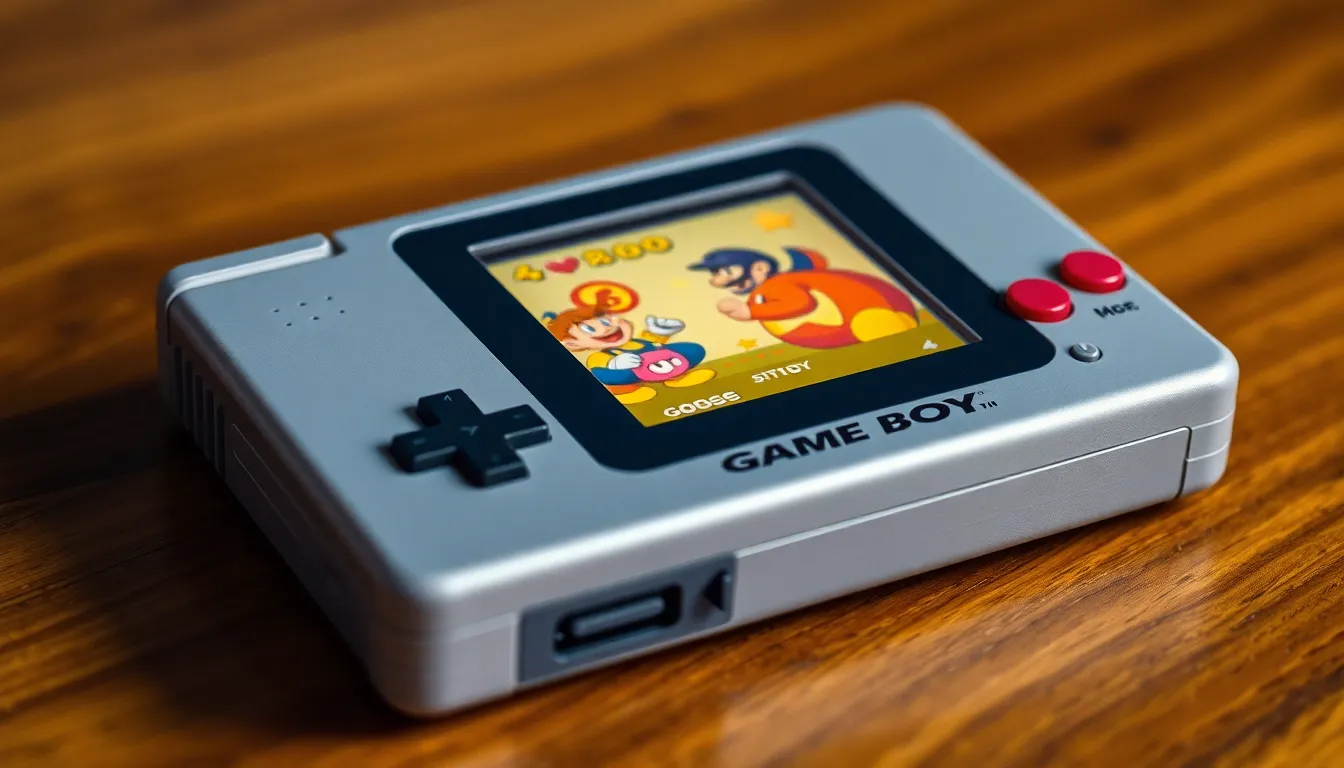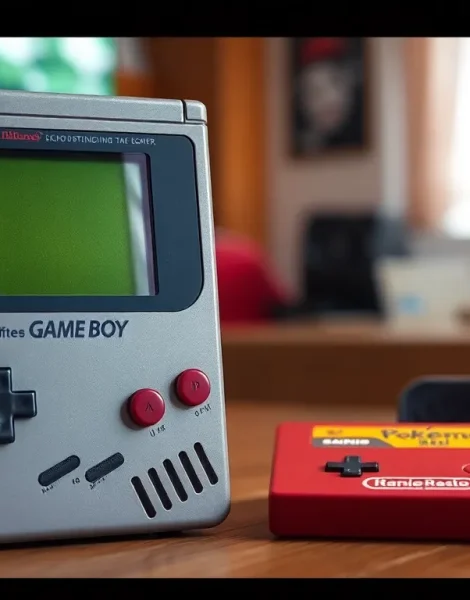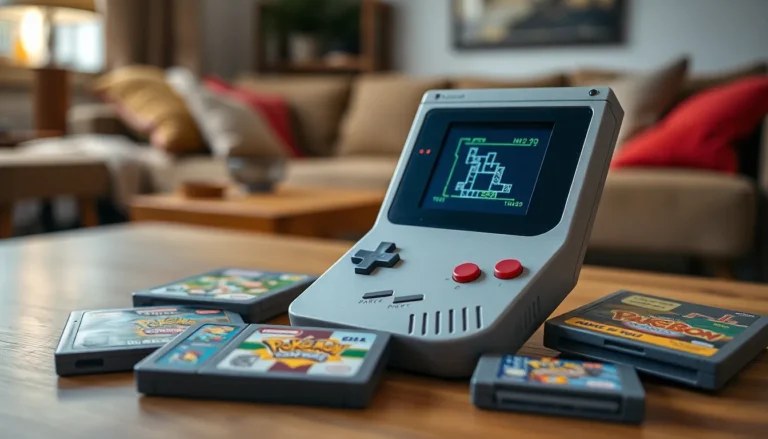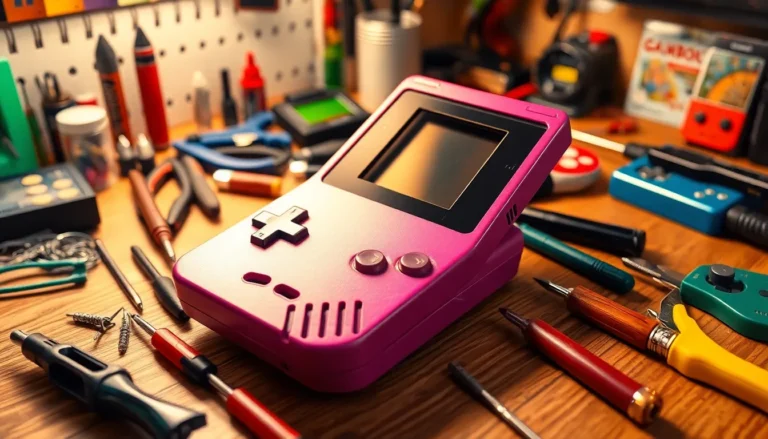The Game Boy revolutionized portable gaming when it hit the market in 1989. With its iconic design and library of unforgettable titles, it captured the hearts of millions worldwide. This handheld console not only introduced gamers to classics like “Tetris” and “Pokémon” but also paved the way for future gaming innovations.
In this article, readers will dive into comprehensive reviews of the Game Boy’s most beloved games. Each review highlights gameplay mechanics graphics and overall experience, offering insights for both nostalgic players and newcomers exploring this gaming gem. Whether revisiting childhood favorites or discovering hidden treasures, the world of Game Boy games promises endless entertainment.
Table of Contents
ToggleOverview of Game Boy
The Game Boy revolutionized portable gaming with its release in 1989. This handheld console introduced a compact design, making gaming accessible anywhere, anytime. Weighing around 0.5 pounds and featuring an iconic greenish screen, the Game Boy combined portability with user-friendly controls.
The original Game Boy supported a diverse library exceeding 1,000 titles. Its most notable games include “Tetris,” recognized for its addictive puzzle mechanics, and the “Pokémon” series, which popularized role-playing games on handheld devices. These titles showcased the console’s ability to deliver engaging gameplay despite its limitations.
Game Boy’s hardware featured an 8-bit processor, which allowed for robust gameplay mechanics while maintaining battery efficiency. The device utilized four monochromatic shades for graphics, which, at the time, were impressive and contributed to its unique aesthetic appeal.
Success led to multiple iterations, including the Game Boy Pocket and Game Boy Advance, each enhancing graphics and gameplay capabilities while retaining core elements. Their retro charm continues to capture audiences, ensuring lasting relevance in gaming history.
Game Boy Design and Features

The Game Boy’s design and features played a crucial role in its lasting popularity. Its compact form made it portable, while its functionality suited gamers of all ages.
Build Quality
Build quality exemplifies durability, ensuring that the Game Boy withstands the rigors of daily play. Constructed with a sturdy plastic shell, the device resists wear and tear over time. The hardware features reliable buttons, which provide tactile feedback, enhancing the overall user experience. Each unit has a notable robustness that allows it to survive drops and extends its lifespan, contributing to the Game Boy’s reputation as a reliable handheld console.
Display and Controls
The display on the Game Boy, a 2.6-inch reflective LCD screen, showcases graphics with a greenish hue, typical of the era. While the resolution measures 160 x 144 pixels, it effectively displays character sprites and backgrounds for various games. Users navigate gameplay with a simple control layout, including a directional pad and four action buttons (A, B, Start, and Select), which enables precise controls. The controls allow for seamless gaming experiences, making titles like “Tetris” and “Pokémon” enjoyable for extended sessions.
Game Boy Library
The Game Boy library features an extensive collection of titles, offering something for every type of gamer. With over 1,000 games available, it includes both classic hits and lesser-known gems that showcase the console’s versatility.
Classic Titles
Classic titles define the Game Boy experience, with games like “Tetris” and the “Pokémon” series standing as cornerstones of handheld gaming.
- Tetris: This puzzle title captivates players with its simple mechanics and addictive gameplay, solidifying its status as a timeless favorite.
- Pokémon Red and Blue: These role-playing games introduce players to the Pokémon universe, combining exploration, battles, and collection elements that transformed the genre.
- The Legend of Zelda: Link’s Awakening: This action-adventure game showcases engaging storytelling and intricate dungeons, expanding the Game Boy’s appeal beyond traditional handheld experiences.
Each classic title contributes to the library’s legacy, providing a nostalgic allure and engaging gameplay that transcends generations.
Hidden Gems
Amidst the well-known titles, several hidden gems enrich the Game Boy library. These games, though less mainstream, offer unique experiences worth discovering.
- Kirby’s Dream Land: This platformer introduces players to Kirby, a lovable character with the ability to inhale enemies and gain their powers, providing an innovative twist on gameplay.
- Gargoyle’s Quest: A unique blend of action and RPG elements, this game allows players to explore a fantastical world while battling enemies and solving puzzles.
- Metroid II: Return of Samus: This action-adventure game features exploration and combat mechanics that immerse players in the Metroid universe, setting a standard for future entries in the series.
These hidden gems highlight the diversity of the Game Boy library, catering to players seeking innovative gameplay and new narratives.
Gameplay Experience
The gameplay experience on the Game Boy delivers a nostalgic yet engaging feel for both seasoned gamers and newcomers. This section explores the key aspects that contribute to its enduring appeal.
Graphics and Sound
Graphics on the Game Boy, while limited to a resolution of 160 x 144 pixels, effectively capture the charm of 8-bit design. Characters and environments are recognizable, with titles like “Pokémon” and “The Legend of Zelda: Link’s Awakening” showcasing vibrant color palettes within the constraints of the hardware. Game developers innovatively utilized shading techniques, bringing depth to in-game graphics. Sound played a critical role in enhancing gameplay; the monophonic audio output created catchy and memorable soundtracks, with iconic jingles that remain etched in players’ memories.
Portability and Battery Life
Portability defines the Game Boy experience, allowing gamers to enjoy titles anytime, anywhere. Its compact size readily fits into pockets or bags, making it a convenient option for travel or on-the-go play. Battery life reinforces its usability; the Game Boy operated on four AA batteries, offering up to 30 hours of gameplay, a feature that encouraged extended gaming sessions. This impressive battery efficiency ensured that players could engage with their favorite titles without constant recharging, solidifying the Game Boy’s status as a pioneer in portable gaming.
Legacy and Impact
The Game Boy’s legacy extends beyond its initial release, establishing itself as a cornerstone in the evolution of portable gaming. It defined the handheld console market, influencing future devices and shaping gaming culture worldwide. Many industry professionals credit the Game Boy with laying the groundwork for subsequent handheld consoles, including the Nintendo DS and the PlayStation Portable (PSP). Its compact design and user-friendly interface created a blueprint that competitors followed for years.
The impact of the Game Boy can be measured by its impressive sales figures, with over 118 million units sold globally. This commercial success demonstrated the viability of handheld gaming as a mainstream entertainment option. The enduring popularity of the Game Boy also led to multiple iterations, such as the Game Boy Color and Game Boy Advance, each introducing enhancements that improved graphics and gameplay while retaining the original’s charm.
Culturally, the Game Boy played a pivotal role in shaping social interactions around gaming. It introduced multiplayer capabilities through link cables, promoting competitive and cooperative play among friends. Iconic franchises like “Pokémon” fostered a sense of community, generating substantial trading and battling activities. Events like Pokémon trading parties became cultural phenomena, contributing to the Game Boy’s status as a social tool in addition to its entertainment value.
The Game Boy’s influence on game design and development remains significant. Many developers cite it as inspiration for creating innovative gameplay mechanics and unique narratives. Its emphasis on accessible gaming broke barriers, allowing a wider audience to engage with video games, including those who may not have considered themselves gamers before. This accessibility changed perceptions and expanded the gaming demographic, impacting industry trends to this day.
In terms of nostalgic value, the Game Boy continues to resonate with players from various generations. Its unique design, memorable games, and the tactile experience of playing on the device evoke a sense of nostalgia that many cherish. Classic games, such as “Tetris” and “The Legend of Zelda: Link’s Awakening,” remain popular today, embraced by both older fans and new players discovering the charm of retro gaming. The Game Boy’s legacy lives on with dedicated fan communities and ongoing discussions surrounding its impact on game development and culture.
The Game Boy’s legacy is undeniable. Its innovative design and extensive library of games have left a lasting imprint on the gaming landscape. From the addictive gameplay of “Tetris” to the adventurous quests in “Pokémon,” it has captivated players for decades.
This handheld console not only introduced portable gaming but also fostered a sense of community among gamers. The blend of nostalgia and engaging gameplay continues to resonate with both seasoned players and newcomers alike. As the gaming world evolves, the Game Boy remains a cherished icon, reminding everyone of the joy of gaming on the go.









